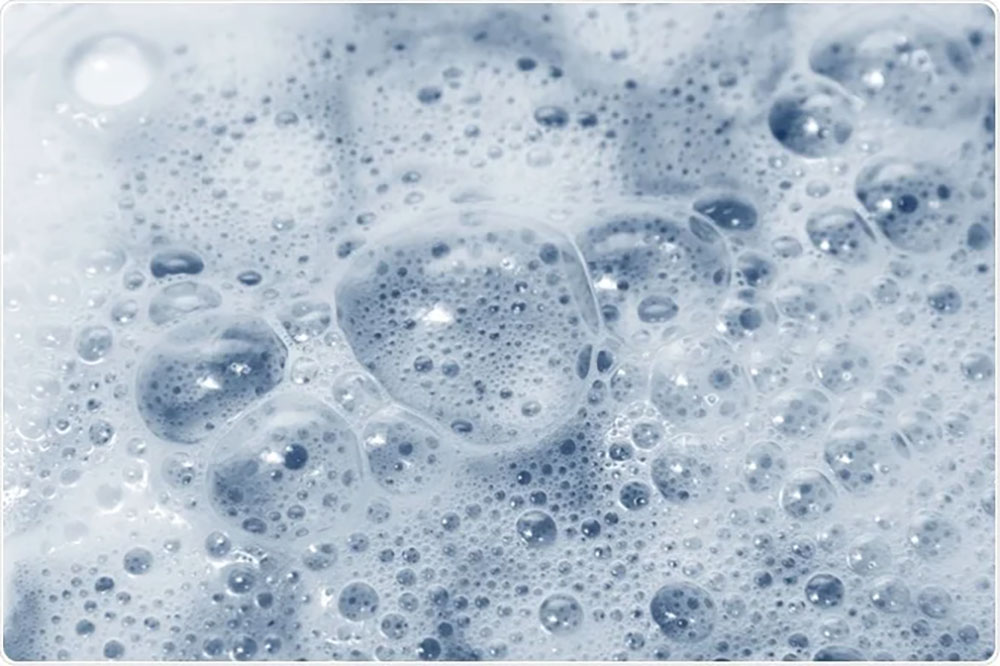Surfactants are all around us and we all use natural and synthetic surfactants every day. Our lives depend on natural surfactants which help us to breathe and to digest our food. 15 million tonnes of surfactants are manufactured every year for use in detergents, shampoos, cosmetics, antifoams, recycling of paper, and many specialty chemicals. But what are they and how can we understand them?
Definition and uses
“Surfactant” is an abbreviated form of “Surface Active Agent”. Surfactants are generally organic molecules with two different functional groups located at either end of the molecule. They are described as Amphiphilic as they have one end which will be hydrophilic (water-loving) and one end which will be hydrophobic (water-hating).
The surfactant will act in a liquid to reduce surface tension and this property can be used by a chemist to create a substance that has the desired properties for their product.
Surfactants have many uses in everyday life. They are used in soaps, detergents, fabric softeners, shampoos, hair conditioners, toothpaste, antifogging chemicals, and cosmetics. They are used in paints, emulsifiers, adhesives, firefighting chemicals, and water treatment. They find uses in biocides, herbicides, insecticides, spermicides, and many specialty chemicals.
Manufacturers
Surfactants are often blended into specialty chemicals to help the active ingredient of the product act at the point where it is required so there are many, many, surfactant suppliers in many countries. The manufacture of base surfactants is dominated by large multinational companies such as;
3M Company (USA)
Akzo Nobel BV (Netherlands)
Arkema S.A. (France)
Ashland Holdings (USA)
BASF (Germany)
Clariant AG (Switzerland)
Croda International PLC (UK)
DKS Co Ltd (Japan)
These companies supply their products to other companies to be incorporated into end-user products often in very small quantities.
Types of surfactant
To understand surfactants, we need to look at the ionic charge on the molecules they are made up of. There are four main categories of surfactants which classify them according to their molecular charge: -
Anionic Surfactants have a negative charge on the hydrophilic end. They are great for lifting and suspending solids and oils and other particles with a positive charge. Anionic surfactants are used mainly in detergents and account for over 50% of the world's production of chemical surfactants in industry. Anionic products often produce foams in water. Commonly used anionic surfactant chemicals are sulfates, sulphonates, and gluconates
Cationic Surfactants have a positive charge on the hydrophilic end. They have good antistatic properties and hence are used in fabric softeners. Cationic surfactants are not normally compatible with anionic surfactants as their charged components react with each other. Cationic surfactants have some antimicrobial properties. Cationic surfactants are often amine products.
Non-ionic Surfactants as the name suggests do not carry an ionic charge. Non-ionic surfactants are the second most common form of surfactant accounting for up to 45% of annual world production. They are good for removing organic material from surfaces and are often non-foaming so they are frequently used in tandem with anionic surfactants in laundry detergents and cleaning products. Common chemicals are ethoxylates, alkoxylates, and cocamides.
Zwitterionic or Amphoteric surfactants are molecules with positive and negative charges which cancel each other out. Changes in pH can make one charge more dominant than the other. In acidic environments, a positive charge will dominate and in an alkaline environment, a negative charge will dominate. These types of surfactant are often expensive and they are used in personal care products such as shampoos and cosmetics. Typical chemicals are betaines, amino oxides, and quaternary amine and carboxylic acid combinations.
Surfactants are often used in cleaning products. The mechanism of their action is that the hydrophobic tail attaches to the soil particle and surrounds it forming a micelle. This micelle has hydrophilic tails on its surface so is lifted by the water away from the surface.
In a laundry detergent for instance the chemist may want to remove organic a nonorganic dirt from a surface or fabric. This may require them to blend anionic and other types of surfactants which will require the creation of a “built product”.
A “Built Product” will usually incorporate at least one surfactant, a builder, a hydrotrope, and a carrier. A hydrotrope is a chemical that keeps the mixture stable when in solution. The carrier is usually a solvent or water which keeps the product in solution or suspension.
Builders are chemicals that help lift, disperse or sequester dirt particles. Laundry detergents are typically built products with a mixture of active ingredients designed to give optimal cleaning power by removing organic and nonorganic stains and sometimes including fabric softener and antistatic treatment as well.
Anionic surfactants can have antimicrobial qualities as they can dissolve the hydrophobic outer layers of viruses and bacteria. This has applications in the current world SARS-CoV-2 pandemic. Research has shown that the addition of surfactant to alcohol and soap hand washes can significantly increase the biocidal activity of the product. It can also improve evaporation reducing drying time for hands as well.
Environmental considerations
The use of surfactants has profound effects on the natural environment. Detergents have a very significant effect on fish and other aquatic organisms as they attack the mucous membranes that protect them from virus and bacterial infection. A concentration of 15ppm of detergent is lethal to adult fish and 5ppm will kill their eggs.
A concentration of as little as 2ppm will increase the absorption of pesticides and some other toxic substances in fish. Surfactants have a significant detrimental effect on the breeding success of many aquatic organisms.
These facts mean that any surfactant used should be carefully chosen and safely disposed of. There are discharge consent levels for surfactants when discharging to watercourses and responsible companies will choose surfactants that biodegrade to harmless substances quickly in the natural environment or sewage treatment works.


